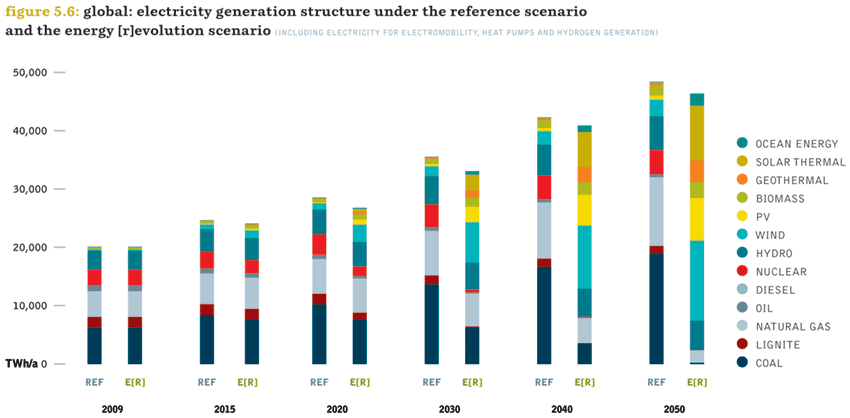Renewable Energy Myths
Dispelling 6 Common Renewable Energy Myths
We hear some of these renewable energy myths ALL the time, so we’re clearing things up with this informational article from GreenPeace. They’ve pulled together some of the six most common myths surrounding renewable energy. Read on to find out what’s true and what’s not.
(Read the full article by clicking here.)
MYTH 1: Renewable Energy Is Too Expensive
"In recent years the costs of wind and solar energy have declined substantially. Today renewable technologies are the most economical solution for new capacity in a growing number of countries and regions, and are typically the most economic solution for new grid-connected capacity where good resources are available…
…There are no input costs for wind and solar energy. So for example, while one needs to buy coal for a coal-fired power plant to generate electricity (and coal mining itself has massive environmental costs), solar and wind energy don’t have input costs like that – sunlight and wind are free. As a result, they replace more expensive production in the electricity market, lowering wholesale electricity prices. This is good for consumers but – unsurprisingly – upsets the producers of dirty energy."
MYTH 2: Renewable Energy is Nice to Have But Not Big Enough
"Renewable energy technology is ready to go, and it is working reliably in countries around the world."
"In the US, nine states are getting 12% or more of their electricity from wind. Iowa & South Dakota exceed 25%."

"World electricity needs could be met almost 100% renewable energy in 2050."
MYTH 3: Renewable Energy Can't Supply Electricity 24/7
"Intelligent technologies can track and manage energy use patterns, provide flexible power that follows demand through the day, use better storage options and group producers together to form virtual power plants. With all these solutions we can secure the renewable energy future needed. We just need smart grids to put it all together and effectively ‘keep the lights on’."
As we often tell our customers, go with what works for you whether it’s solar power or wind turbines, but pair them up when you can. Wind turbines have the ability to charge your battery bank at night and on cloudy, overcast days while your solar panels can generate power when the wind isn’t blowing. Hybrid systems are the best way to go if you don’t have to compromise.
MYTH 4: Electricity Grid Can't Handle Renewable Energy
"An electricity grid – the system that connects power stations to consumers – can handle large shares of variable renewable energy if it is designed to do so. Adding wind and solar on top of ‘business as usual’ is not how it works. What’s needed is a gradual transformation of the whole energy system to accommodate modern energy production and consumption."
"A smart grid is a system that can connect (and switch between) a number of energy sources (solar, wind, etc.), at many different sites, to provide a constant flow of electricity to users. It allows us to create a network of electricity production sites that spread over a wide area."

MYTH 5: Renewable Energy is Bad for the Environment
"Birds and bats: A common argument against wind farms is that they kill birds and bats. However, if environmental impact assessments are conducted and migratory and local bird population patterns are assessed before construction, this is avoided completely. It is vital that these assessments are made to ensure the safety of birds and bats, as with any development project"
"Noise: Studies have shown that noise complaints, especially those related to wind farms, are often unrelated to actual noise. In most cases it was found that people were actually opposed to the farms on aesthetic grounds – which would be the same with coal or nuclear plants. It was also found that ‘noise’ complaints dropped off rapidly when local communities derived income from the renewable energy projects in question."
"Land Use: The land used for renewable energy projects, like wind farms, can still be used for farming and cattle grazing. International experience has shown that livestock are completely unaffected by the presence of wind farms and will often graze right up to the base of wind turbines."
"Footprint of Renewables: Unlike coal and nuclear RE pays off its carbon footprint and does so relatively quickly. Depending on where they are made, solar panels offset their carbon footprint in about four years."
We commonly get asked about (or accused) bird deaths with wind turbines. We’ve not personally experienced any bird fatalities at our location and could argue that a typical cat is more of threat than your residential wind turbine. We do suggest, however, that you stay away from clear wind turbine blades if bird safety is one of your main concerns.
MYTH 6: Greenpeace Wants To Turn Off Coal and Nuclear Power Plants Today
"Greenpeace’s Energy [R]evolution model is about a gradual transition to renewable energy. It’s a blueprint which has been developed for over 30 countries and regions for decreasing our reliance on coal, oil, gas and nuclear over time, while investing increasingly in renewables."
"Fully switching over to renewable energy involves 3 steps."
-
Increase our energy efficiency: This is most important. It is about using our energy wisely, so that we get more done while using less and less energy.
-
Shift investments to renewable energy projects, and steadily increase investments over time.
-
Stop investing in new fossil fuels and nuclear plants whilst also shutting down old stations as they reach the end of their lifespans.
Original Article/Source:http://www.greenpeace.org/international/en/campaigns/climate-change/energyrevolution/renewable-energy-myths/
